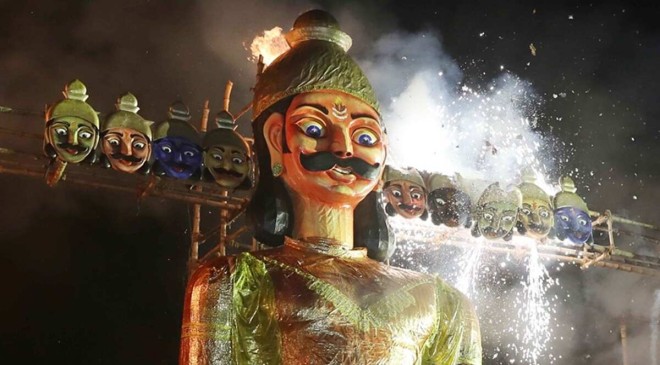Dussehra or Vijayadashami falls on the tenth day of Navratri. It marks the victory of good over evil. Learn its date, history, significance, and celebrations.
The auspicious festival of Dussehra is right around the corner. Also known as Vijayadashami, Dasara or Dashain, the day marks the victory of good over evil, as on this day, Lord Rama defeated demon king Ravana and Maa Durga won over Mahishasura. It falls on the tenth day of the month of Ashwin, seventh in the Hindu Luni-Solar Calendar. After the nine days of Navratri, devotees of Maa Durga celebrate Dussehra with much pomp on the tenth day. While the term Dussehra is more common in North Indian states and Karnataka, Vijayadashami is popular in West Bengal. Bengalis celebrate the festival by performing Durga Visarjan as devotees take idols of Maa Durga for immersion in holy water bodies. Additionally, Ram Lila is performed across the country, fairs are organised on a large scale, and people throng in huge numbers to see Ravan effigies go up in flames.
Read More: Navratri 2023, Day 6: Worship Maa Katyayani- Know Shubh Muhurat, Mantras And More
When is Dussehra 2023? Vijayadashami Puja Muhurat:
Dussehra or Vijayadashami is on October 24. The Vijaya Muhurat begins at 1:58 pm and ends at 2:43 pm, says Drik Panchang. The afternoon Puja time is from 1:13 pm to 3:28 pm. While the Dashami Tithi will start on October 23 at 5:44 pm and end on October 24 at 3:14 pm, the Shravana Nakshatra is from October 22 at 6:44 pm till October 23 at 5:14 pm.
Dussehra 2023: Vijayadashami History and Significance
Dussehra falls on Shukla Paksha Dashmi during the month of Ashwin per the Hindu lunar calendar and a day after Maha Navami or at the end of Shardiya Navratri. Viajayadashami marks the victory of good over evil. According to Hindu mythology, Lord Rama defeated the demon king of Lanka, Ravana, on this day. Another legend says that Maa Durga defeated Mahishasura after a fierce battle that lasted for nine days.
Dussehra also marks the beginning of Diwali celebrations. It falls twenty days before the festivals of light – marking Lord Rama, Maa Sita and Lord Lakshman’s homecoming. The festival of Vijayadashmi preaches the ethos of the victory of good over evil and light over darkness. On this day, people pray for prosperity and good health. Additionally, worshipping the Shami tree on the day of Vijayadashami holds great significance in some parts of the country, as it is believed that Arjun hid his weapons inside the Shami tree during his exile.
Read More: Dry Cough: 5 Ayurvedic Home Remedies To Treat Sore Throat Naturally
Dussehra 2023: Vijayadashami Celebrations
In North India and a few other parts of the country, Dussehra or Vijayadashami is celebrated by burning effigies of Ravana, brother of the Lanka King – Kumbhkaran, and the courageous warrior son of Ravana – Meghnad. Ramlila, an enactment of Rama’s story, is organised on all nine days of Navratri. It culminates with the killing of Ravana on the tenth day. Dussehra also signifies getting rid of sins or bad qualities, as the ten heads of Ravana symbolise one bad quality.
In Bengal, devotees immerse the idols of Maa Durga in water bodies and bid her a grand adieu. They also wish the Goddess to come next year and keep an eye on them while warding off all the evils and miseries.





































